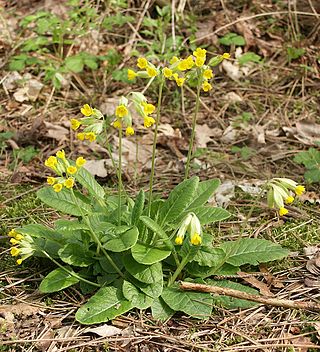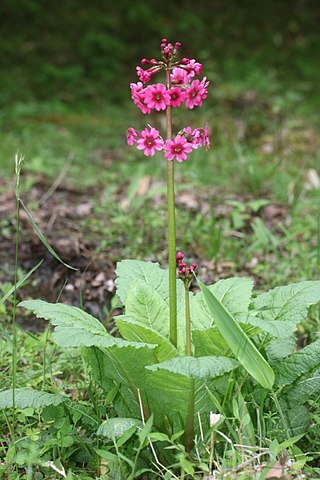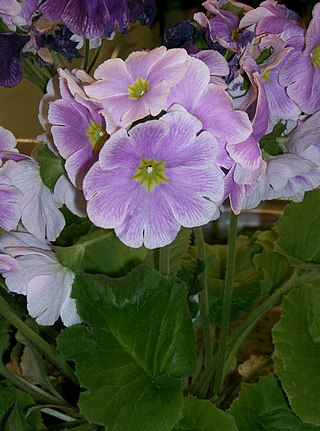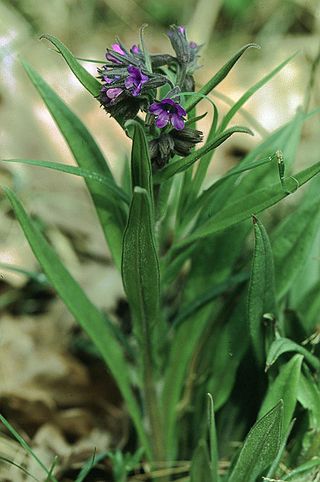
Primula is a genus of herbaceous flowering plants in the family Primulaceae. They include the primrose, a familiar wildflower of banks and verges. Other common species are P. auricula (auricula), P. veris (cowslip), and P. elatior (oxlip). These species and many others are valued for their ornamental flowers. They have been extensively cultivated and hybridised. Primula are native to the temperate Northern Hemisphere, south into tropical mountains in Ethiopia, Indonesia, and New Guinea, and in temperate southern South America. Almost half of the known species are from the Himalayas.

Primula veris, the cowslip, common cowslip, or cowslip primrose, is a herbaceous perennial flowering plant in the primrose family Primulaceae. The species is native throughout most of temperate Europe and western Asia, and although absent from more northerly areas including much of northwest Scotland, it reappears in northernmost Sutherland and Orkney and in Scandinavia. This species frequently hybridizes with other Primulas such as the common primrose Primula vulgaris to form false oxlip which is often confused with true oxlip, a much rarer plant.

Caltha palustris, known as marsh-marigold and kingcup, is a small to medium size perennial herbaceous plant of the buttercup family, native to marshes, fens, ditches and wet woodland in temperate regions of the Northern Hemisphere. It flowers between April and August, dependent on altitude and latitude, but occasional flowers may occur at other times.

Silene chalcedonica, the Maltese-cross or scarlet lychnis, is a species of flowering plant in the family Caryophyllaceae, native to Eurasia. Other common names include flower of Bristol, Jerusalem cross and nonesuch.

Primula vulgaris, the common primrose, is a species of flowering plant in the family Primulaceae, native to western and southern Europe, northwest Africa, and parts of southwest Asia. The common name is primrose, or occasionally common primrose or English primrose to distinguish it from other Primula species also called primroses. None of these are closely related to the evening primroses.

Erica vagans, the Cornish heath or wandering heath, is a species of flowering plant in the family Ericaceae, native to Ireland, Cornwall, western France and Spain. It is a vigorous, spreading, evergreen heather reaching 75 cm (30 in) tall and wide, with pink flowers borne in racemes 14 cm (6 in) long in summer and autumn. The Latin specific epithet vagans literally means "wandering"; in this context it means "widely distributed".

Primula auricula, often known as auricula, mountain cowslip or bear's ear, is a species of flowering plant in the family Primulaceae, that grows on basic rocks in the mountain ranges of central Europe, including the western Alps, Jura Mountains, the Vosges, the Black Forest and the Tatra Mountains.

Primula florindae, the Tibetan cowslip or giant cowslip, is a species of flowering plant in the family Primulaceae, native to southeastern Tibet, where it grows in huge numbers close to rivers such as the Tsangpo. It is a substantial herbaceous perennial growing to 120 cm (47 in) tall by 90 cm (35 in) wide. In summer the flower stalks rise from basal rosettes of 5–20 cm (2–8 in) long leaves. They bear clusters of 20–40 yellow, pendent, bell-like, delicately scented flowers with a mealy white bloom.

Myosotis sylvatica, the wood forget-me-not or woodland forget-me-not, is a species of flowering plant in the family Boraginaceae, native to Europe. This spring-flowering plant and its cultivars, typically with blue flowers, are the familiar forget-me-nots of gardens.

Salvia pratensis, the meadow clary or meadow sage, is a species of flowering plant in the family Lamiaceae, native to Europe, western Asia and northern Africa. The Latin specific epithet pratensis means "of meadows", referring to its preferred habitat. It also grows in scrub edges and woodland borders.

Genista tinctoria, the dyer's greenweed or dyer's broom, is a species of flowering plant in the family Fabaceae. Its other common names include dyer's whin, waxen woad and waxen wood. The Latin specific epithet tinctoria means "used as a dye".

Primula sikkimensis is a species of flowering plant in the family Primulaceae, native to the Himalayan region at altitudes of 3,200–4,400 m (10,499–14,436 ft), from western Nepal to south west China. It is an herbaceous perennial growing to 90 cm (35 in) tall by 60 cm (24 in) broad, with umbels of fragrant yellow flowers, appearing in summer on slender stems which arise from basal rosettes of leaves. The flowers may be covered by a mealy-white layer (farina).

Inula magnifica, the giant fleabane, is a species of flowering plant in the sunflower family Asteraceae, native to the eastern Caucasus. It is a tall herbaceous perennial growing to 1.8 m (6 ft) tall by 1 m (3 ft) broad, with hairy stems and leaves. In late summer it bears rich yellow, daisy-like composite flower-heads 15 cm (6 in) in diameter, with narrowly tubular ray florets. It is suitable for planting at the back of a border, or in a wild meadow or prairie-style garden.

Primula japonica, the Japanese primrose, Japanese cowslip, Queen of primroses, or valley red, is a species of flowering plant in the family Primulaceae, native to Japan. The common name Japanese primrose also applies to the related species Primula sieboldii.

Primula marginata, the silver-edged primrose, is a species of flowering plant in the family Primulaceae, native to the south western Alps of France and Italy.

Primula obconica is a species of flowering plant in the family Primulaceae, native to China. It is a short-lived evergreen perennial growing to 40 cm (16 in) tall by 25 cm (10 in) broad, with rosettes of coarse, heart-shaped leaves, and thick stalks bearing umbels of lavender flowers in late winter and early spring.

Primula pulverulenta, the mealy primrose or mealy cowslip, is a species of flowering plant in the family Primulaceae, native to damp habitats in China. It is a herbaceous perennial growing to 100 cm (39 in) tall by 60 cm (24 in) broad, with strong stems of deep pink flowers arising from basal rosettes of leaves in early summer. The flowers are grouped at intervals along the stem in a tiered formation, hence the common name "candelabra primula" which is often applied to this and other species with a similar arrangement.

Pulmonaria angustifolia, the narrow-leaved lungwort or blue cowslip, is a species of flowering plant in the family Boraginaceae, native to central and north eastern Europe. Growing to 30 cm (12 in) tall by 45 cm (18 in) broad, it is an herbaceous perennial with hairy oval leaves and masses of bright blue flowers in spring. The subspecies azureus has brighter blue flowers.

Primula frondosa, the leafy primrose, is a species of flowering plant in the family Primulaceae, native to the Balkans. It inhabits shady spots in a small region of the central Balkan Mountains range in Bulgaria, where it is found at altitudes from 800 to 2,200 m. Its populations are situated within the boundaries of the Central Balkan National Park and the nature reserves Sokolna, Dzhendema and Stara Reka.

Primula × polyantha, the polyanthus primrose or false oxlip, is a naturally occurring hybrid species of flowering plant in the family Primulaceae. It is the result of crosses between Primula veris and Primula vulgaris. It is native to Europe, found where the parent species' ranges overlap, and many artificial hybrid cultivars have also been created for the garden trade. Naturally‑occurring individuals tend to have yellow flowers, while a wide range of flower colors has been developed in the cultivars over the centuries.





















